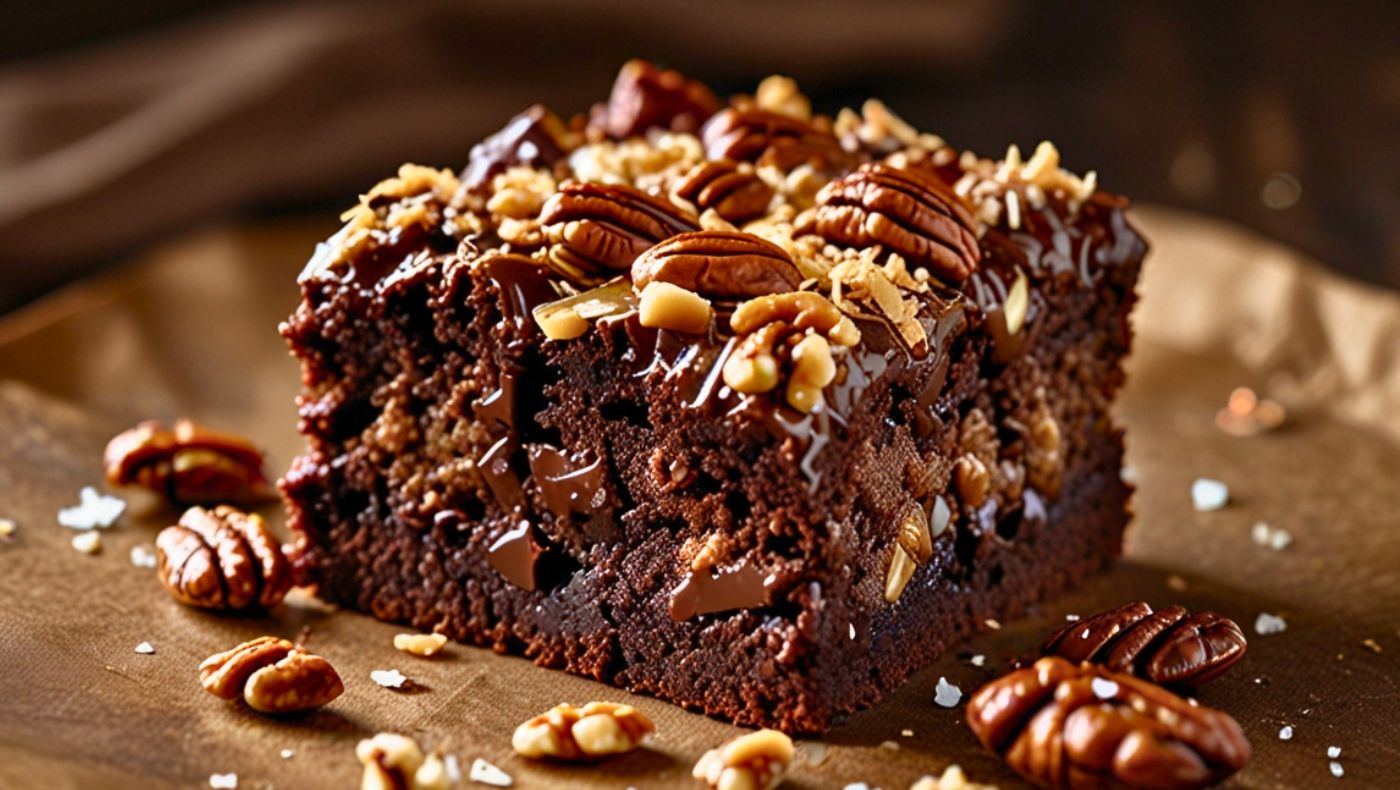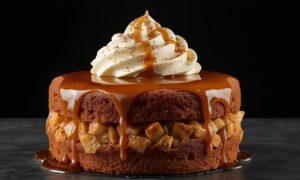Ever bite into a dessert so rich it makes you pause mid chew? German Chocolate Brownies do exactly that. They don’t just satisfy, they surprise you. Fudgy chocolate meets gooey coconut pecan topping. Every bite delivers texture, flavor, and pure indulgence.
Here’s the twist: German Chocolate Brownies aren’t German. They’re named after Samuel German, who created special dark baking chocolate in the 1850s. That signature flavor became a beloved classic worldwide.
Want something warm, chewy, and memorable? These brownies deliver. Soft centers. Crisp edges. Dreamy coconut pecan topping. They check every box.
You’ll learn the step by step process using simple tools and pantry staples. No fancy tricks. Just bold, sweet flavor done right.
This post covers tips for perfect texture, tricks to layer the topping, and ideas to make your brownies stand out. Whether you’re baking for a party, a quiet night in, or just because, you’ll have a go to recipe that never fails.
Ready to bake something special? Let’s dive into German Chocolate Brownies, where every bite feels like a warm hug.
Ingredients & Substitutions
For the Brownie Base:
- 8 oz dark chocolate (70% cacao), chopped
- 1 cup unsalted butter
- 1¾ cups granulated sugar
- 4 large eggs, room temperature
- 1 teaspoon vanilla extract
- 1 cup all purpose flour
- ½ teaspoon salt
- ⅓ cup unsweetened cocoa powder
For the German Chocolate Topping:
- 1 cup evaporated milk
- 1 cup granulated sugar
- 3 large egg yolks
- ½ cup unsalted butter
- 1 teaspoon vanilla extract
- 1⅓ cups sweetened shredded coconut
- 1 cup chopped pecans, toasted
Chocolate choice drives success. Many recipes call for semi sweet chocolate. I prefer 70% dark chocolate. It balances the sweet topping perfectly. No bitterness appears. Valrhona or Ghirardelli work best. Avoid anything below 60% cacao. You need chocolate intensity.
Dietary modifications work well. The brownie base adapts to gluten free flour. Bob’s Red Mill 1:1 baking flour works perfectly. No texture changes occur. Coconut oil substitutes for butter. You lose some richness though. Maintain the fat to flour ratio. This creates perfect fudgy texture.
Egg substitutions prove tricky. Flax eggs work but change texture. They create more cake like results. For the topping, egg yolks are irreplaceable. They create silky custard base. This holds everything together. Use room temperature eggs. They incorporate more easily. They prevent chocolate from seizing with hot butter.
You cannot substitute evaporated milk. Regular milk won’t work. Cream won’t work either. Evaporated milk’s concentrated nature matters. Its slight caramelization during processing creates authentic flavor. Heavy cream makes topping too rich. Regular milk makes it too thin.
Step by Step Instructions
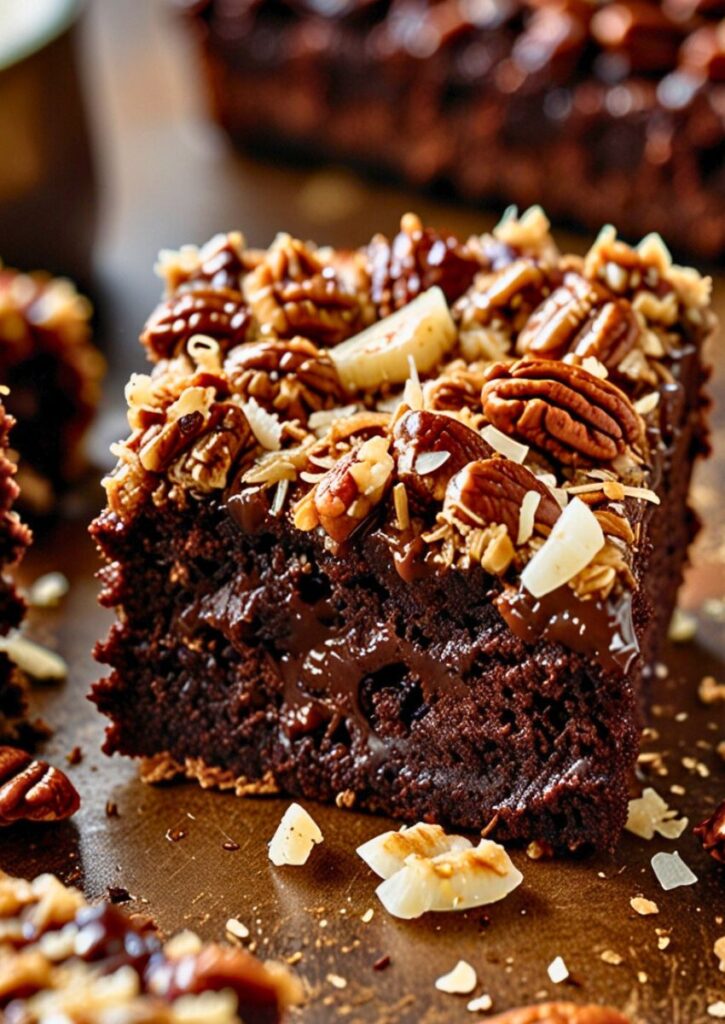
Preparing the Brownie Base
Preheat oven to 350°F. Line a 9×13 inch pan with parchment paper. Leave overhang for easy removal. This size creates perfect thickness ratio. Brownie and topping balance perfectly.
Melt chocolate and butter together. Use a double boiler or microwave. Heat in 30-second intervals. The mixture should look smooth and glossy. Not grainy. Stir between each microwave interval. This prevents burning. Cool for 5 minutes before continuing.
Whisk sugar into chocolate mixture. Incorporate fully. Add eggs one at a time. Beat well after each addition. This gradual process prevents scrambling. Eggs won’t cook against warm chocolate. The mixture becomes lighter and slightly fluffy.
Stir in vanilla extract. Sift flour, cocoa powder, and salt together. Fold dry ingredients into chocolate mixture. Mix just until combined. Overmixing develops gluten. This creates tough brownies instead of fudgy ones.
Pour batter into prepared pan. Bake for 25-28 minutes. The center should jiggle slightly when shaken. Residual heat continues cooking. Insert a toothpick in center. It should come out with few moist crumbs.
Creating the German Chocolate Topping
Prepare topping while brownies bake. Combine evaporated milk, sugar, and egg yolks. Use a heavy bottomed saucepan. Cook over medium heat. Stir constantly. Cook until mixture thickens. It should coat the back of a spoon. This takes 8-12 minutes. Patience is required.
The mixture will thicken suddenly. Don’t panic when this happens. Remove from heat immediately. Stir in butter and vanilla until smooth. Residual heat melts the butter completely.
Fold in coconut and toasted pecans. The mixture should spread easily. Not too stiff though. Add evaporated milk if too thick. Use one tablespoon. Return to low heat if too thin. Cook for another minute or two.
Toast pecans yourself. Don’t buy pre toasted ones. Spread them on a baking sheet. Toast at 350°F for 8-10 minutes. Wait until fragrant. This step adds incredible depth to the final product.
Assembly and Final Baking
Spread warm topping over hot brownies immediately. Remove brownies from oven first. Don’t let them cool. The warm surface helps topping adhere. It creates better flavor integration.
Return to oven for 10-12 minutes more. Topping should turn lightly golden. It should set properly. Edges will caramelize slightly. Don’t let them burn.
Cool completely in the pan before cutting. This step is crucial. Cutting too early creates messy, gooey squares. They fall apart. Patience rewards you with clean, professional squares.
Cooking Techniques & Science
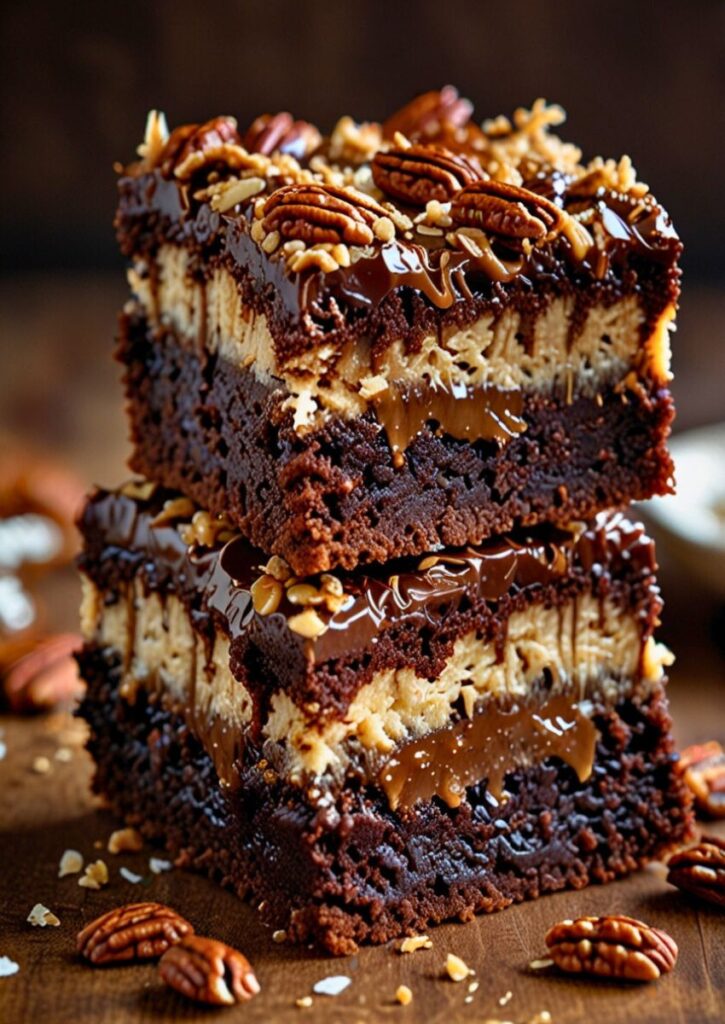
Perfect German Chocolate Brownies require understanding science. The brownie base uses the Maillard reaction. Proteins and sugars create complex chocolate flavors. The topping depends on controlled caramelization. Protein coagulation also plays a role.
Temperature control becomes critical for custard like topping. Egg yolks coagulate at 160°F. Constant stirring is essential. Medium heat prevents problems. Too high heat scrambles eggs. You get lumpy custard instead of smooth. Evaporated milk’s lower water content helps prevent curdling. It provides richness simultaneously.
Double baking serves multiple purposes. It sets the topping properly. Additional heat creates slight crust on coconut pecan layer. The brownie beneath finishes cooking gently. This prevents overcooked edges and undercooked centers.
Proper pan preparation creates professional results. Parchment paper with overhang allows clean removal. The 9×13 size creates optimal thickness ratios. Smaller pans create overly thick brownies. They don’t cook evenly. Larger pans create thin brownies. They can’t support topping weight.
The cooling process involves residual cooking and structure formation. Brownies cool and chocolate firms up. Proteins set and create perfect fudgy texture. Rushing this process creates gooey, unstable squares. They lack professional appearance.
Serving & Pairing Suggestions
German Chocolate Brownies deserve thoughtful presentation. Cut them into perfect 2-inch squares. Use a sharp knife wiped clean between cuts. Dark brownie base contrasts with golden topping. This creates natural visual appeal.
For elegant presentation, dust serving plates lightly with cocoa powder. Add small dollops of unsweetened whipped cream. The cream’s acidity cuts through richness. It adds textural contrast. Fresh raspberries provide color and tartness. They complement the coconut beautifully.
These brownies pair beautifully with coffee. Dark roasts work best. They echo chocolate intensity. Cold brew concentrate mixed with cream creates ideal accompaniment. It doesn’t compete with dessert complexity. For wine pairings, consider port or late harvest Riesling. Both have enough sweetness to harmonize without overwhelming.
Temperature affects eating experience significantly. Serve at room temperature for maximum flavor development. Serve slightly warm with vanilla ice cream for indulgent presentation. Coconut pecan topping becomes slightly chewy when cold. Some prefer this texture. Room temperature allows all flavors to shine equally.
For special occasions, consider individual presentations. Use a 2-inch ring mold to create perfect cylinders. Drizzle plates with chocolate sauce or caramel. This creates restaurant quality plating that impresses dinner guests.
Storage and Make Ahead Tips
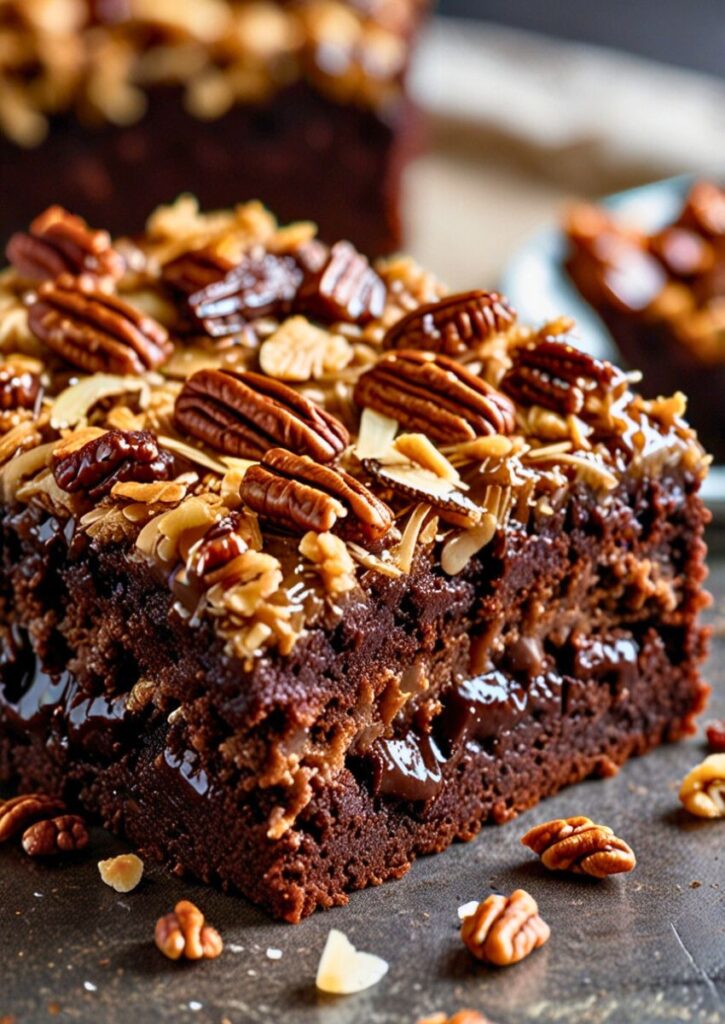
German Chocolate Brownies improve after 24 hours. Flavors meld and textures settle. Store covered at room temperature for four days. Refrigerate for up to one week. Coconut topping may firm when chilled. It returns to perfect consistency at room temperature.
These freeze exceptionally well for three months. Wrap individually in plastic wrap. Store in airtight containers. Thaw overnight in refrigerator. Bring to room temperature before serving. Texture remains remarkably intact after freezing.
For make ahead preparation, bake brownie base two days early. Store covered. Prepare topping fresh on serving day. This ensures optimal texture and flavor. This approach works well for large gatherings where timing matters.
Professional bakers prepare topping in advance. They rewarm gently before spreading. This technique requires careful reheating. Use low heat and stir constantly. This prevents separation or overcooking.
German Chocolate Brownies represent American dessert fusion at its peak. They combine German chocolate cake’s beloved flavors with brownie’s beloved texture. The result transcends both original desserts. It creates something uniquely satisfying. It appeals to diverse palates. Master this recipe and you’ll own a signature dessert. It consistently impresses while showcasing serious baking skills.
The key to success lies in understanding each component’s role and executing with precision and patience. From properly melting chocolate to achieving perfect custard consistency, every step contributes to the final masterpiece. These aren’t just brownies with coconut on top, they’re a sophisticated dessert that deserves a place in every serious baker’s repertoire.
Frequently Asked Questions
Q: Why do my German Chocolate Brownies fall apart when I cut them?
A: This usually happens when the brownies haven’t cooled completely or when the brownie base is undercooked. Always cool for at least 2 hours before cutting, and ensure the base has a slight jiggle but isn’t liquid when you remove it from the oven. Using a sharp knife wiped clean between cuts also prevents dragging and tearing.
Q: Can I make the coconut pecan topping ahead of time?
A: Yes, but with caution. The topping can be made up to 2 days ahead and refrigerated. Reheat gently over low heat, stirring constantly, until spreadable. Add a tablespoon of evaporated milk if it seems too thick. Fresh topping always tastes better, so make ahead only when necessary.
Q: My topping turned out runny instead of thick. What went wrong?
A: The most common cause is not cooking the custard base long enough. The mixture needs to coat the back of a spoon and hold its shape. If this happens, return the mixture to low heat and cook while stirring until it thickens. Alternatively, insufficient egg yolks or using regular milk instead of evaporated milk can cause this issue.
Q: How do I prevent the chocolate from seizing when making the brownie base?
A: Ensure all utensils are completely dry, as even small amounts of water can cause chocolate to seize. Melt chocolate and butter together slowly, either in a double boiler or microwave in short intervals. Let the mixture cool slightly before adding other ingredients, and make sure eggs are at room temperature to prevent temperature shock.
Q: Can I use a different pan size for this recipe?
A: While possible, changing pan size affects cooking time and final texture. A 9×9 inch pan creates thicker brownies that need 5-10 minutes longer baking time. An 11×15 inch pan creates thinner brownies that bake faster but may not support the topping weight as well. Stick with 9×13 inch for best results.

Swiftly Captions by Tina Smith — Quick, flavorful food recipes made simple, bringing fresh inspiration to your kitchen every day
